Qiufu Li
BCE vs. CE in Deep Feature Learning
May 09, 2025Abstract:When training classification models, it expects that the learned features are compact within classes, and can well separate different classes. As the dominant loss function for training classification models, minimizing cross-entropy (CE) loss maximizes the compactness and distinctiveness, i.e., reaching neural collapse (NC). The recent works show that binary CE (BCE) performs also well in multi-class tasks. In this paper, we compare BCE and CE in deep feature learning. For the first time, we prove that BCE can also maximize the intra-class compactness and inter-class distinctiveness when reaching its minimum, i.e., leading to NC. We point out that CE measures the relative values of decision scores in the model training, implicitly enhancing the feature properties by classifying samples one-by-one. In contrast, BCE measures the absolute values of decision scores and adjust the positive/negative decision scores across all samples to uniformly high/low levels. Meanwhile, the classifier biases in BCE present a substantial constraint on the decision scores to explicitly enhance the feature properties in the training. The experimental results are aligned with above analysis, and show that BCE could improve the classification and leads to better compactness and distinctiveness among sample features. The codes will be released.
Distilled Transformers with Locally Enhanced Global Representations for Face Forgery Detection
Dec 28, 2024Abstract:Face forgery detection (FFD) is devoted to detecting the authenticity of face images. Although current CNN-based works achieve outstanding performance in FFD, they are susceptible to capturing local forgery patterns generated by various manipulation methods. Though transformer-based detectors exhibit improvements in modeling global dependencies, they are not good at exploring local forgery artifacts. Hybrid transformer-based networks are designed to capture local and global manipulated traces, but they tend to suffer from the attention collapse issue as the transformer block goes deeper. Besides, soft labels are rarely available. In this paper, we propose a distilled transformer network (DTN) to capture both rich local and global forgery traces and learn general and common representations for different forgery faces. Specifically, we design a mixture of expert (MoE) module to mine various robust forgery embeddings. Moreover, a locally-enhanced vision transformer (LEVT) module is proposed to learn locally-enhanced global representations. We design a lightweight multi-attention scaling (MAS) module to avoid attention collapse, which can be plugged and played in any transformer-based models with only a slight increase in computational costs. In addition, we propose a deepfake self-distillation (DSD) scheme to provide the model with abundant soft label information. Extensive experiments show that the proposed method surpasses the state of the arts on five deepfake datasets.
WiNet: Wavelet-based Incremental Learning for Efficient Medical Image Registration
Jul 18, 2024Abstract:Deep image registration has demonstrated exceptional accuracy and fast inference. Recent advances have adopted either multiple cascades or pyramid architectures to estimate dense deformation fields in a coarse-to-fine manner. However, due to the cascaded nature and repeated composition/warping operations on feature maps, these methods negatively increase memory usage during training and testing. Moreover, such approaches lack explicit constraints on the learning process of small deformations at different scales, thus lacking explainability. In this study, we introduce a model-driven WiNet that incrementally estimates scale-wise wavelet coefficients for the displacement/velocity field across various scales, utilizing the wavelet coefficients derived from the original input image pair. By exploiting the properties of the wavelet transform, these estimated coefficients facilitate the seamless reconstruction of a full-resolution displacement/velocity field via our devised inverse discrete wavelet transform (IDWT) layer. This approach avoids the complexities of cascading networks or composition operations, making our WiNet an explainable and efficient competitor with other coarse-to-fine methods. Extensive experimental results from two 3D datasets show that our WiNet is accurate and GPU efficient. The code is available at https://github.com/x-xc/WiNet .
EPL: Empirical Prototype Learning for Deep Face Recognition
May 21, 2024Abstract:Prototype learning is widely used in face recognition, which takes the row vectors of coefficient matrix in the last linear layer of the feature extraction model as the prototypes for each class. When the prototypes are updated using the facial sample feature gradients in the model training, they are prone to being pulled away from the class center by the hard samples, resulting in decreased overall model performance. In this paper, we explicitly define prototypes as the expectations of sample features in each class and design the empirical prototypes using the existing samples in the dataset. We then devise a strategy to adaptively update these empirical prototypes during the model training based on the similarity between the sample features and the empirical prototypes. Furthermore, we propose an empirical prototype learning (EPL) method, which utilizes an adaptive margin parameter with respect to sample features. EPL assigns larger margins to the normal samples and smaller margins to the hard samples, allowing the learned empirical prototypes to better reflect the class center dominated by the normal samples and finally pull the hard samples towards the empirical prototypes through the learning. The extensive experiments on MFR, IJB-C, LFW, CFP-FP, AgeDB, and MegaFace demonstrate the effectiveness of EPL. Our code is available at $\href{https://github.com/WakingHours-GitHub/EPL}{https://github.com/WakingHours-GitHub/EPL}$.
Rediscovering BCE Loss for Uniform Classification
Mar 12, 2024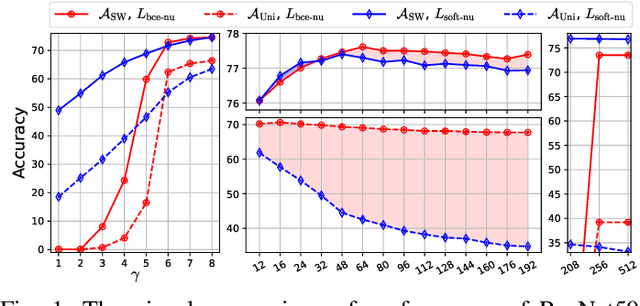
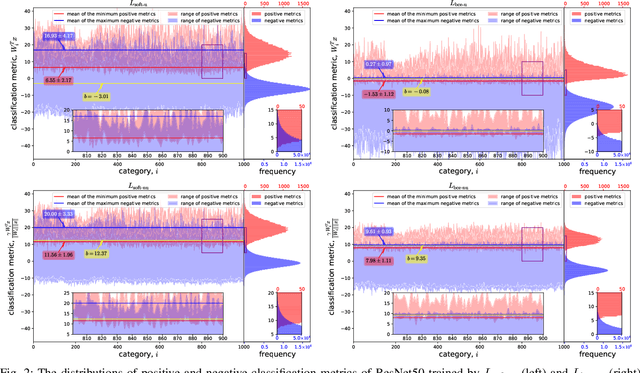
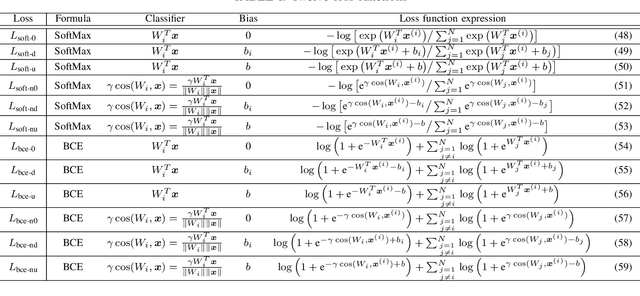

Abstract:This paper introduces the concept of uniform classification, which employs a unified threshold to classify all samples rather than adaptive threshold classifying each individual sample. We also propose the uniform classification accuracy as a metric to measure the model's performance in uniform classification. Furthermore, begin with a naive loss, we mathematically derive a loss function suitable for the uniform classification, which is the BCE function integrated with a unified bias. We demonstrate the unified threshold could be learned via the bias. The extensive experiments on six classification datasets and three feature extraction models show that, compared to the SoftMax loss, the models trained with the BCE loss not only exhibit higher uniform classification accuracy but also higher sample-wise classification accuracy. In addition, the learned bias from BCE loss is very close to the unified threshold used in the uniform classification. The features extracted by the models trained with BCE loss not only possess uniformity but also demonstrate better intra-class compactness and inter-class distinctiveness, yielding superior performance on open-set tasks such as face recognition.
UniTSFace: Unified Threshold Integrated Sample-to-Sample Loss for Face Recognition
Nov 04, 2023



Abstract:Sample-to-class-based face recognition models can not fully explore the cross-sample relationship among large amounts of facial images, while sample-to-sample-based models require sophisticated pairing processes for training. Furthermore, neither method satisfies the requirements of real-world face verification applications, which expect a unified threshold separating positive from negative facial pairs. In this paper, we propose a unified threshold integrated sample-to-sample based loss (USS loss), which features an explicit unified threshold for distinguishing positive from negative pairs. Inspired by our USS loss, we also derive the sample-to-sample based softmax and BCE losses, and discuss their relationship. Extensive evaluation on multiple benchmark datasets, including MFR, IJB-C, LFW, CFP-FP, AgeDB, and MegaFace, demonstrates that the proposed USS loss is highly efficient and can work seamlessly with sample-to-class-based losses. The embedded loss (USS and sample-to-class Softmax loss) overcomes the pitfalls of previous approaches and the trained facial model UniTSFace exhibits exceptional performance, outperforming state-of-the-art methods, such as CosFace, ArcFace, VPL, AnchorFace, and UNPG. Our code is available.
Activation Template Matching Loss for Explainable Face Recognition
Jul 05, 2022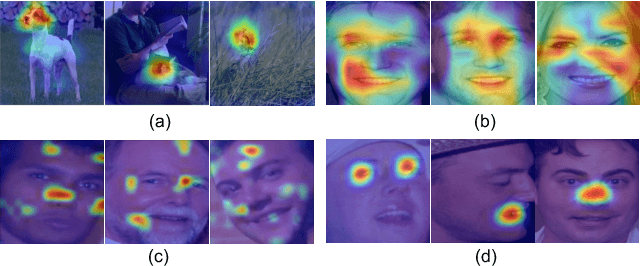
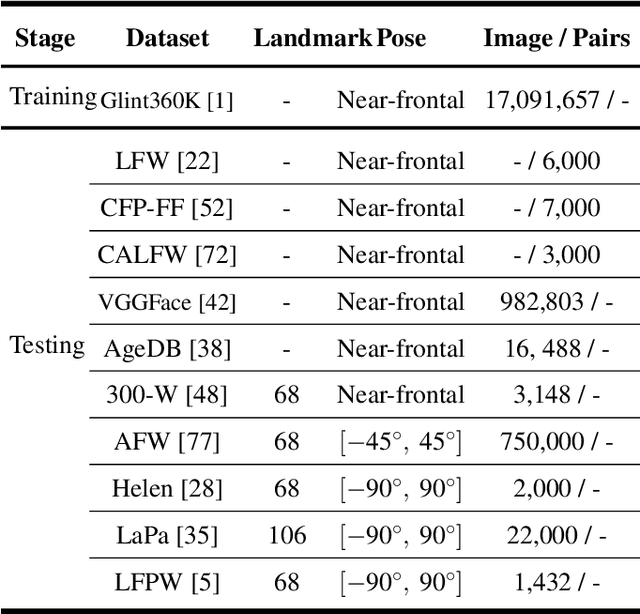
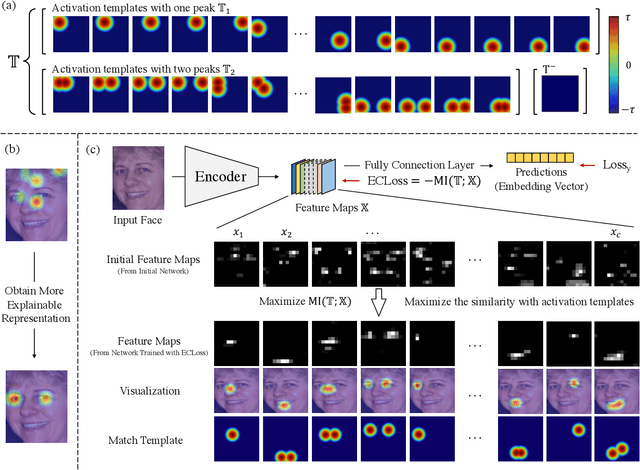

Abstract:Can we construct an explainable face recognition network able to learn a facial part-based feature like eyes, nose, mouth and so forth, without any manual annotation or additionalsion datasets? In this paper, we propose a generic Explainable Channel Loss (ECLoss) to construct an explainable face recognition network. The explainable network trained with ECLoss can easily learn the facial part-based representation on the target convolutional layer, where an individual channel can detect a certain face part. Our experiments on dozens of datasets show that ECLoss achieves superior explainability metrics, and at the same time improves the performance of face verification without face alignment. In addition, our visualization results also illustrate the effectiveness of the proposed ECLoss.
WaveCNet: Wavelet Integrated CNNs to Suppress Aliasing Effect for Noise-Robust Image Classification
Jul 28, 2021



Abstract:Though widely used in image classification, convolutional neural networks (CNNs) are prone to noise interruptions, i.e. the CNN output can be drastically changed by small image noise. To improve the noise robustness, we try to integrate CNNs with wavelet by replacing the common down-sampling (max-pooling, strided-convolution, and average pooling) with discrete wavelet transform (DWT). We firstly propose general DWT and inverse DWT (IDWT) layers applicable to various orthogonal and biorthogonal discrete wavelets like Haar, Daubechies, and Cohen, etc., and then design wavelet integrated CNNs (WaveCNets) by integrating DWT into the commonly used CNNs (VGG, ResNets, and DenseNet). During the down-sampling, WaveCNets apply DWT to decompose the feature maps into the low-frequency and high-frequency components. Containing the main information including the basic object structures, the low-frequency component is transmitted into the following layers to generate robust high-level features. The high-frequency components are dropped to remove most of the data noises. The experimental results show that %wavelet accelerates the CNN training, and WaveCNets achieve higher accuracy on ImageNet than various vanilla CNNs. We have also tested the performance of WaveCNets on the noisy version of ImageNet, ImageNet-C and six adversarial attacks, the results suggest that the proposed DWT/IDWT layers could provide better noise-robustness and adversarial robustness. When applying WaveCNets as backbones, the performance of object detectors (i.e., faster R-CNN and RetinaNet) on COCO detection dataset are consistently improved. We believe that suppression of aliasing effect, i.e. separation of low frequency and high frequency information, is the main advantages of our approach. The code of our DWT/IDWT layer and different WaveCNets are available at https://github.com/CVI-SZU/WaveCNet.
3D WaveUNet: 3D Wavelet Integrated Encoder-Decoder Network for Neuron Segmentation
Jun 01, 2021



Abstract:3D neuron segmentation is a key step for the neuron digital reconstruction, which is essential for exploring brain circuits and understanding brain functions. However, the fine line-shaped nerve fibers of neuron could spread in a large region, which brings great computational cost to the segmentation in 3D neuronal images. Meanwhile, the strong noises and disconnected nerve fibers in the image bring great challenges to the task. In this paper, we propose a 3D wavelet and deep learning based 3D neuron segmentation method. The neuronal image is first partitioned into neuronal cubes to simplify the segmentation task. Then, we design 3D WaveUNet, the first 3D wavelet integrated encoder-decoder network, to segment the nerve fibers in the cubes; the wavelets could assist the deep networks in suppressing data noise and connecting the broken fibers. We also produce a Neuronal Cube Dataset (NeuCuDa) using the biggest available annotated neuronal image dataset, BigNeuron, to train 3D WaveUNet. Finally, the nerve fibers segmented in cubes are assembled to generate the complete neuron, which is digitally reconstructed using an available automatic tracing algorithm. The experimental results show that our neuron segmentation method could completely extract the target neuron in noisy neuronal images. The integrated 3D wavelets can efficiently improve the performance of 3D neuron segmentation and reconstruction. The code and pre-trained models for this work will be available at https://github.com/LiQiufu/3D-WaveUNet.
WaveSNet: Wavelet Integrated Deep Networks for Image Segmentation
May 29, 2020



Abstract:In deep networks, the lost data details significantly degrade the performances of image segmentation. In this paper, we propose to apply Discrete Wavelet Transform (DWT) to extract the data details during feature map down-sampling, and adopt Inverse DWT (IDWT) with the extracted details during the up-sampling to recover the details. We firstly transform DWT/IDWT as general network layers, which are applicable to 1D/2D/3D data and various wavelets like Haar, Cohen, and Daubechies, etc. Then, we design wavelet integrated deep networks for image segmentation (WaveSNets) based on various architectures, including U-Net, SegNet, and DeepLabv3+. Due to the effectiveness of the DWT/IDWT in processing data details, experimental results on CamVid, Pascal VOC, and Cityscapes show that our WaveSNets achieve better segmentation performances than their vanilla versions.
 Add to Chrome
Add to Chrome Add to Firefox
Add to Firefox Add to Edge
Add to Edge